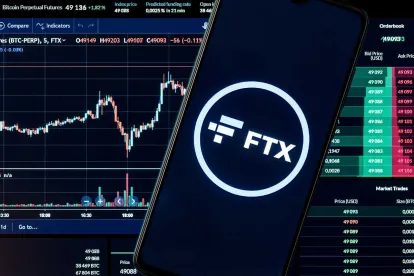While investors have been lamenting the “crypto winter” that started in May 2021, no one predicted the rapid and unprecedented collapse of Bahamas-based crypto exchange FTX Digital Markets (FTX). On November 7, 2022, crypto investors in FTX saw their fortunes vanish overnight, totaling billions of dollars. Everyone in the crypto market, including sophisticated investors and regulators alike, was blind-sided by this high-profile shock, which is generating massive commentary and speculation in the media and investment community.
While investigations are still under way and there are many questions to be answered, it appears that FTX ran into trouble by loaning customers’ crypto assets to FTX’s affiliated crypto trading firm, Alameda Research (Alameda), to make risky bets. Alameda was forced into selling crypto assets, which had a declining pricing pressure. This created a downward spiral since other investors may have been forced to sell due to liquidity concerns.
Typically, exchanges are required to safeguard customer assets, and this undisclosed lending to affiliate Alameda may constitute a violation of FTX’s terms of service. In traditional, regulated financial systems, brokerages are required to segregate customer funds from funds used for proprietary trading by the firm. The systemic effects of this incident have both short- and long-term consequences, including the loss of confidence in the crypto markets overall. Following news of FTX’s collapse, the price of cryptocurrencies such as Bitcoin dropped in volatile trading. Some commentators have compared the FTX debacle to the collapse of Bear Stearns during the 2008 financial crisis. One key difference is that unregulated institutions and exchanges such as FTX cannot be bailed out by the federal government.
An Exposition of the Fall
Critics of FTX have lambasted CEO Sam Bankman-Fried who goes by his initials “SBF.” Just weeks ago, SBF was a hugely popular, high-profile figure who had bailed out numerous other flagging crypto firms and drew novice investors with slick Super Bowl ads, celebrity endorsements and naming rights to the Miami Heat’s basketball arena. He also was known to court politicians and regulators in the hopes of softer U.S. regulation and oversight of the crypto markets. Despite investment capital flowing into FTX from large institutional players and venture capital firms, there appears to have been little due diligence, risk management or board oversight of FTX’s trading and lending activities.
Meanwhile, the FTX saga continues to unfold. Bahamian regulators have frozen FTX’s assets on the exchange. FTX has filed for bankruptcy protection in the Bahamas and in the United States. FTX is not the first crypto firm to file for chapter 11 in the U.S. bankruptcy courts this year. However, the opaqueness of the FTX customers and ownership of assets will create significant legal hurdles for recovery and reorganization.
As reflected in a recent FTX Delaware bankruptcy court filing by John Ray, who has been engaged as the chief restructuring officer for the FTX debtors:
Never in my career have I seen such a complete failure of corporate controls and such a complete absence of trustworthy financial information as occurred here. From compromised systems integrity and faulty regulatory oversight abroad, to the concentration of control in the hands of a very small group of inexperienced, unsophisticated and potentially compromised individuals, this situation is unprecedented.
This is significant criticism coming from the same individual who was involved in the liquidation of assets and distribution to creditors in the Enron debacle in the early 2000s. It is noteworthy that FTX was one of the few crypto companies that was purportedly audited under Generally Accepted Accounting Principles (GAAP) and received a clean bill of health.
The U.S. Securities and Exchange Commission (SEC) and Department of Justice (DOJ) are conducting investigations of FTX and its principals. Congressional hearings are expected to take place in December, and a new Digital Assets Working Group has been formed as a subcommittee of the U.S. House of Representatives Committee on Financial Services.
Notably, investors are not the only ones harmed by FTX’s downfall. Many of FTX’s employees were caught by surprise when the company imploded and also suffered adverse financial consequences. According to some news reports, some employees were paid via direct deposit to their accounts on the FTX exchange. When FTX’s assets were frozen, employees could not retrieve their funds.
A Silver Lining?
Some pundits have noted the potential silver lining of FTX’s collapse, which could catalyze U.S. regulators to implement new laws regulating the existing “Wild West” of the crypto marketplace. Currently, there is no U.S. regulation on spot markets for crypto, and there is undoubtedly a need for greater regulatory clarity. Fortunately, there appears to be bipartisan support in Congress for crypto regulation. U.S. regulation and oversight of crypto markets eventually may move this asset class into the mainstream. Balanced and informed crypto oversight and regulation should be welcomed by the industry and serve to build trust in the system. This is particularly important when considering the fact that major pension funds and endowments are investing heavily in crypto. Ultimately, the crypto market could be regulated much like securities and commodities.
Meanwhile, in the long term, enthusiasts are optimistic about the technological revolution of blockchain underpinning crypto and digital assets. Significant capital continues to flow into blockchain based on positive fundamentals, including multiple-use cases for this disruptive technology that may change the face of business in years to come. However, in the short term, many institutions and investors will sit on the sidelines until there is greater regulatory clarity and transparency in crypto markets.



 />i
/>i

